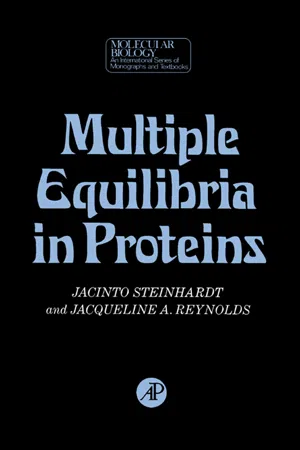Chemistry
Titration Curve of Amino Acids
The titration curve of amino acids illustrates the pH changes that occur as the amino acid is titrated with a strong base. At the start, the amino acid exists in its acidic form, and as the base is added, the pH rises until the amino acid reaches its isoelectric point, where it becomes electrically neutral. After this point, the pH continues to rise as the base is added.
Written by Perlego with AI-assistance
Related key terms
Related key terms
1 of 4
Related key terms
1 of 3
5 Key excerpts on "Titration Curve of Amino Acids"
- eBook - ePub
- James F. Pankow(Author)
- 2019(Publication Date)
- CRC Press(Publisher)
For alkalimetric and acidimetric titrations, the titration curve is usually plotted as pH vs. amount (e.g., volume) of strong base or strong acid added. Here, however, since we want to discuss things in a general context, for the x -axis rather than volume, we will mostly use the value of C B − C A that is produced in the solution (or the related parameter f, defined below). If the concentration in the titrant is sufficiently large relative to the concentration of what is being titrated (say 20×), then near-constancy in the value of A T (or B T, etc.) in the solution can be assumed over the course of the titration: the volume of titrant added does not significantly increase the volume of solution being titrated so that A T (or B T, etc.) is not significantly lowered during the titration. This assumption simplifies computing titration curves. While the mathematics of titrations might be viewed as, well, tedious and confusing, it is fundamentally important for understanding how aqueous solutions behave in response to changes in acid or base content. First, most of the salt in the oceans is the result of the grand back-and-forth chemical neutralization that has occurred over geologic time of metal oxide bases from terrestrial solids reacting with added HCl from volcanism and vice versa (Schilling et al., 1978). Second, natural waters undergo titration changes whenever there are spills of strong acid or base, and when acid rain falls on a lake watershed system. Third, laboratory titrations are routinely used in analytical determinations of “alkalinity” in samples of: (1) natural water; and (2) water flowing through waste and drinking water treatment plants, to provide input information for calculations regarding pH control - eBook - ePub
- John Kenkel(Author)
- 2013(Publication Date)
- CRC Press(Publisher)
a ’s are indicated).5.2.3 Titration of Monobasic Strong and Weak Bases
Now consider an alternative in which the acid is in the buret and the base is in the reaction flask. If the titration of 0.10 N NaOH with a 0.10-N HCl (a strong base titrated with strong acid) is considered, we have a curve that starts at a high pH value (a solution of a base has a high pH) and ends at a low pH–just the opposite to that observed when titrating an acid with a base (see Figure 5.3 a). Likewise, the curves for 0.10 N weak bases, titrated with a strong acid, such as ammonium hydroxide titrated with HCl, start out at a lower pH compared with the strong base, just as those for 0.10 N weak acids started out at a higher pH compared with the strong acid (see Figure 5.3 b). A family of curves for the titration of bases with acids is given in Figure 5.4 . These curves have a theoretical foundation as well and can be calculated.5.2.4 Equivalence Point Detection
FIGURE 5.3 Titration curves for the titration of (a) 0.10 N NaOH titrated with 0.10 N HCl and (b) 0.10 N NH4 OH titrated with 0.10 N HCl.Before continuing with other examples, it is important to consider how the equivalence point in an acid–base titration is found and what relationship this has with titration curves. As we have said, the inflection point at the center of these curves occurs at the equivalence point, the point at which all of the substance titrated has been exactly consumed by the titrant. The exact position for this in the strong acid titrated with strong base case, and also the strong base titrated with strong acid case, is at pH 7, exactly in the middle of the inflection point. For the weak acid with strong base case, the equivalence point is again in the middle of the inflection point, but this occurs at a pH higher than pH 7 (refer to Figure 5.2 ). In fact, the weaker the acid, the higher the pH value that corresponds to the equivalence point. The opposite is observed in the case of the weak base with strong acid cases (see Figure 5.4 - eBook - ePub
- Jacinto Steinhardt, Jacqueline A. Reynolds, Bernard Horecker, Nathan O. Kaplan, Julius Marmur(Authors)
- 2014(Publication Date)
- Academic Press(Publisher)
i are not known, this is most easily accomplished by computer using an iterative program which varies the five parameters until the best fit is obtained.Between pH 5 and 8, imidazoles, α-amino groups, and sulf hydryls may be involved, and some independent knowledge, such as amino acid composition, of the numbers of identical groups in at least two of the above three sets is necessary.From pH 8 to 12 both ε-amino and tyrosines dissociate their protons. Fortunately, the tyrosine ionization curve can be determined independently by spectrophotometric titration (Chapter III , p. 42 ) and the results subtracted from the potentiometric data to give n for e-amino groups only.Arginine residues generally titrate only above pH 12, and their total number, n, in any given protein is computed by the following means.The total number of protons dissociated between the acid end point and the isoionic point,Δ, is by definition equal to the total number of positive charges on the protein at Z = 0. Thus, once the number of charged imidazoles, α-aminos, and ε-aminos at Z = 0 is known, the arginine count is established by subtracting the sum (His+ + α-amino + + Lys+ ) fromZ ¯maxΔ.Z ¯maxThe ionizable residues in proteins may also be identified by their heats of ionization, as Wyman (1939) and others have shown. It is clear from Table 5-3 that carboxyl groups have ΔH ionization ± 2 kcal/mole, while for imidazoles and phenolic groups ΔH ionization 5-6 kcal/mole, and for ammonium and guanidinium ΔH ionization 10-12 kcal/mole. Figure 5-1 shows ΔH ionization for the dissociation of H + from serum albumin. Approximately 100 groups have ΔH ionization values anticipated for COO− , 10 have ΔH ionization 7 kcal/ mole. The fact that tyrosine and lysine titrate in the same pH region but have different ΔH ionization is noted in Fig. 5-1 where ΔH ionization - eBook - ePub
Food Protein Chemistry
An Introduction for Food Scientists
- Joe Regenstein(Author)
- 2012(Publication Date)
- Academic Press(Publisher)
The degree of reaction is often different in the free amino acids because of the zwitterion nature of the compound. (Zwitterions do not exist in the middle of the protein because the free α -carboxyl and the free α -amino are lost in formation of the protein.) A detailed listing of some individual chemical reactions of amino acids can be found in Appendix 4-2. ACID–BASE PROPERTIES The isoelectric point of an amino acid is the point at which the amino acid has no net electrical charge. It is an important characteristic for any amino acid, because every amino acid has at least two acid–base (titratable) groups. This definition of an isoelectric point is an operational definition, that is, one that specifies an experiment and a particular result which then constitute the defined term. Clearly, the definition depends on the clarity and specificity of the experimental description and results as well as on the accuracy and precision with which the experiment can be done. (Define the difference between accuracy and precision.) Another important property of an amino acid is the association constant of the individual reactive groups. This is usually expressed as a p K, the negative log of K (the dissociation constant). These numbers change as the solution conditions change. It may be helpful to review a few concepts about acids and bases before beginning the more detailed discussion of isoelectric points and p K values. Our first problem is that of nomenclature. Strictly speaking, —CO 2 – and —NH 2 are bases because each of these groups can accept a hydrogen ion. However, the carboxyl group is usually considered acidic and the amino group basic. This is based on the fact that the p K of the carboxyl group is on the acid side of neutral and the p K of the amino group is on the alkaline side. Each acid–base pair must have an acid and a conjugate base (or a base and conjugate acid) - eBook - ePub
- Clyde Frank(Author)
- 2012(Publication Date)
- Academic Press(Publisher)
b .Molecules with Both Acidic and Basic Properties
There are several different systems which contain both acidic and basic groups. Many of these are organic molecules and are of biological and pharmaceutical interest. Two typical examples are amino acids and sulfonamides. Glycine (I ), the simplest amino acid, and sulfanilanilide (II ) are shown below.The procedure for discussing the equilibrium steps and for making calculations of pH for solutions of these compounds is exactly the same as for polyprotic acids. Using glycine as an example, the ionization steps are as follows:Hence, the equilibrium constants are tabulated as successive ionization constants of the most highly protonated form and the system is treated as a polyprotic acid.It should be noted that compounds like glycine, which have acidic and basic properties, will exist at some particular pH value in the neutral form. However, it is observed that their solutions possess ionic character. This results because of internal ionization and systems of this type are called zwitterions. For glycine the neutral and internal ionized forms areExample 8-17
Calculate the pH of a 0.0100 F phenylalanine solution. Phenylalanine is an essential amino acid in human nutrition, and is not synthesized by the human body. Recommended intake for a normal male is about 2.2 g/day.The equilibria areThe main phenylalanine species must be HP because of the magnitude of Ka1and Ka2
Index pages curate the most relevant extracts from our library of academic textbooks. They’ve been created using an in-house natural language model (NLM), each adding context and meaning to key research topics.
Explore more topic indexes
Explore more topic indexes
1 of 6
Explore more topic indexes
1 of 4




